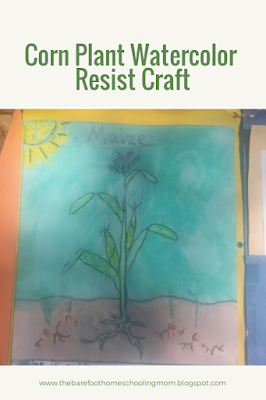Earlier this year we spent some time studying the ancient civilizations of South America and Central America. One of the things we learned about was the domestication of the corn plant and the important role it played in allowing people to settle down. In this post I share instructions for a fun corn plant watercolor resist craft we did. This craft went great with our ancient civilizations unit but would also be great to do while studying plant science or as a harvest season craft.
For this craft you will need:
-A piece of white paper
-Crayons
-Watercolors
-A paint brush
-A popcorn kernel
-Glue
-A cup of water for painting
First have your child draw and color a corn plant, roots and all with crayons.
Or print out a coloring sheet of a corn plant to color with crayons. Here's a free corn plant printable from getdrawings.com.
Next have your child paint over their drawing or coloring sheet with water colors. Have them paint a sky towards the top of the page and brown soil at the bottom around the plant's roots.
Set it aside to dry.
When the paint is fully dry, glue the corn kernel at the bottom of the stem, just inside the soil so it looks like the plant and roots sprouted from the seed.
Corn Plant Watercolor Resist Craft:
For this craft you will need:
-A piece of white paper
-Crayons
-Watercolors
-A paint brush
-A popcorn kernel
-Glue
-A cup of water for painting
First have your child draw and color a corn plant, roots and all with crayons.
Next have your child paint over their drawing or coloring sheet with water colors. Have them paint a sky towards the top of the page and brown soil at the bottom around the plant's roots.
Set it aside to dry.
When the paint is fully dry, glue the corn kernel at the bottom of the stem, just inside the soil so it looks like the plant and roots sprouted from the seed.
Extend The Learning:
Check out this cool time lapse video of a corn plant growing:
For more information about the domestication of the corn plant and it's historical importance, check out:
If you enjoyed this post, check out:
Follow me on:



Comments
Post a Comment